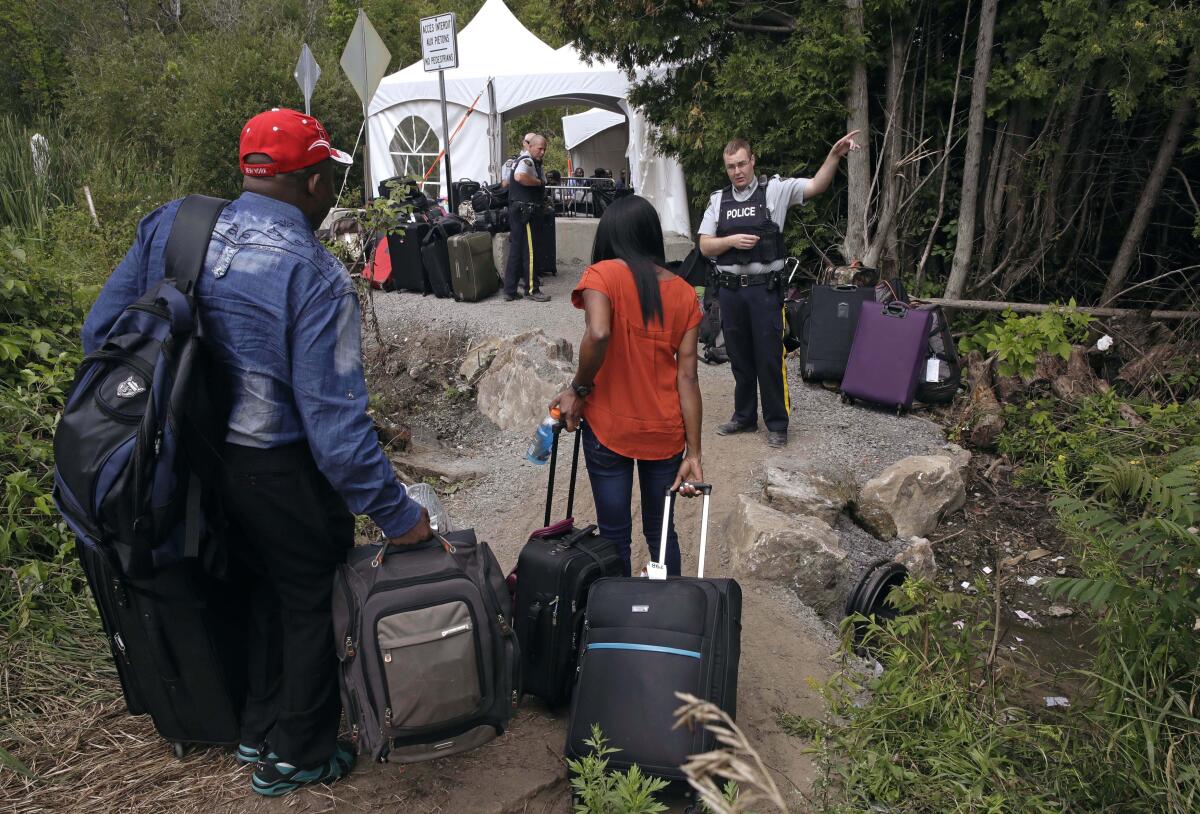Opinion: Now Trump’s cruel border policy is spreading in Canada

- Share via
At almost 4,000 miles, the United States’ northern border is about twice as long as the U.S.-Mexico border — much of it wild, unmarked and dangerously cold for half the year. And yet, human smuggling and deaths at the U.S.-Canada border have not been a major phenomenon, as they have been down south. Nor has Canada poured billions of dollars into a network of walls, fences, robotic dogs and militarized border patrol. It is also true that historically the number of asylum seekers and migrants seeking entry to Canada has been relatively low.
But the ills of the U.S.-Mexico border seem bound to spread northward, now that Canada reached a deal with the Biden administration to expand a 2004 agreement to repel Canada-bound asylum seekers back to the United States (and vice versa).
As U.S. policies toward asylum seekers grew harsher from 2017 on, the number attempting to enter Canada increased. Instead of appealing to its southern neighbor to do better, Canada is coordinating with the U.S. to pass the buck on the legal obligation to protect refugees, which both countries undertook when they signed the Refugee Convention and Protocol more than 50 years ago. Their current approach foists responsibility onto poorer, less stable countries that are already doing more than their share.
Both the U.S. and Canada have pursued this under a “safe third country” rule, which enables a country to return asylum seekers to a nation they have passed through on their journey if it is considered safe and deemed to have a fair process for seeking protection. That “safe third country” then has the responsibility to determine their claims.
Efforts by the former Trump administration to apply this logic at the southern border were repeatedly struck down by the courts, finding Mexico and other countries of transit not safe.
Canada has followed the same approach since 2004, when it entered into the Canada-U.S. Safe Third Country Agreement. Back then about 14,000 asylum seekers annually sought entry to Canada along the U.S. border, and a few hundred moved in the opposite direction. By design, the agreement only applied to migrants who traversed at official land ports of entry. A Parliamentary Committee cautioned in 2002 that if the agreement led to increased irregular border crossings, Canada should be prepared to terminate the agreement.
After Trump’s election, more asylum seekers headed north, and to avoid being sent back, they entered between official ports of entry. Biden’s failure to reverse the worst of Trump’s policies has led increasing numbers of individuals to hope for the chance of protection in Canada. In the past year, about 40,000 have crossed into Canada at an informal border crossing called Roxham Road, in Quebec.
This has been labeled a crisis, but it simply isn’t, especially when one considers that 85% of the world’s refugees are hosted in lower- and middle-income countries. Furthermore, Canada knows how to manage refugee inflows decently when it chooses to do so: Over 160,000 Ukrainian refugees have been welcomed during the past year.
But rather than terminate the deal, Canada negotiated an expansion of the Safe Third Country Agreement. Now it can send far more people back to the U.S. to pursue asylum claims — not just individuals who crossed at official ports of entry but also those who entered anywhere else along the land border.
Activists have brought legal challenges to end the 2004 deal, but in the meantime the two governments are expanding it. Among other impacts, this amounts to a job-creation program for smugglers at the border.
Trial courts in Canada have twice ruled against the policy. The Supreme Court of Canada is currently considering an appeal on the legality of the Safe Third Country Agreement, based on the contention that the U.S. is not a “safe” third country — because it detains asylum seekers in abusive conditions (including solitary confinement) and denies refugees a fair chance to prove they would face persecution if deported. And conditions in the U.S. have only worsened since the court’s ruling.
Keep in mind what the U.S. plans to do with asylum seekers sent from Canada. It would pass the buck to Mexico and other countries south of the border by labeling them safe and proposing regulations (dubbed by many as an “asylum ban”) that will allow the U.S., with limited exceptions, to deny asylum to those who transited through those countries without applying for asylum.
A number of those nations, such as Guatemala, El Salvador, Honduras and Nicaragua, have abysmal human rights conditions, and consequently are origin countries for a significant proportion of asylum seekers. They also lack anything approaching functional asylum systems.
The Safe Third Country Agreement and related policies subvert the obligations to which Canada and the U.S. are subject under international refugee law. They undermine the existing global system of protection. But most tragically, they abandon principle and humanity, and set off a chain reaction that ends up returning refugees to persecution.
Karen Musalo is a law professor and the founding director of the Center for Gender and Refugee Studies at UC Law, San Francisco. Audrey Macklin is the director of the Centre for Criminology and Sociolegal Studies at the University of Toronto.
More to Read
A cure for the common opinion
Get thought-provoking perspectives with our weekly newsletter.
You may occasionally receive promotional content from the Los Angeles Times.










